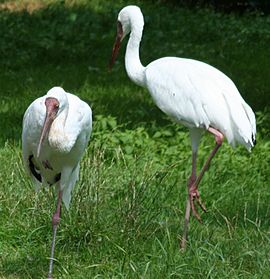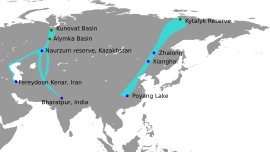Siberian crane facts for kids
Quick facts for kids Siberian crane |
|
|---|---|
 |
|
| Siberian crane | |
| Conservation status | |
| Scientific classification | |
| Kingdom: | |
| Class: | |
| Order: | |
| Family: | |
| Genus: | |
| Binomial name | |
| Grus leucogeranus |
|
 |
|
| Route used by Siberian cranes in migration | |
The Siberian crane (Grus leucogeranus) or Siberian white crane or snow crane, is a critically endangered crane. They occur in three groups: the eastern group, which migrates from eastern Siberia to China, the central group, which migrates from western Siberia to India, and the western group, which migrate from western Russia to Iran.
Contents
Description
Adults of both genders have a pure white plumage except for the black primaries, alula and primary coverts. The fore-crown, face and side of head is bare and brick red, the bill is dark and the legs are pinkish. The iris is yellowish. Juveniles are feathered on the face and the plumage is dingy brown. There are no elongated tertial feathers as in some other crane species. During breeding season, both the male and female cranes are often seen with mud streaking their feathers. They dip their beaks in mud and smear it on their feathers. The call is very different from the trumpeting of most cranes and is a goose-like high pitched whistling toyoya. They typically weigh 4.9–8.6 kg (11–19 lb) and stand about 140 cm (55 in) tall. The wingspan is 210–230 cm (83–91 in) and length is 115–127 cm (45–50 in). Males are on average larger than females. There is a single record of an outsized male of this species weighing 15 kg (33 lb).
Populations
Adult Siberian cranes are 140 cm (5 ft) tall and weight 6 kg (13 lbs). Their plumage is pure white, except for some wing feathers, which are black. The front of the face does not have any feathers and is reddish in color.The Siberian crane is a migratory species with three major populations, or groups.
The eastern group is estimated to contain around 3000-4000 cranes, over 95% of the total population. In 2008, 3,750 individuals were counted at Poyang Lake in China, one of the breeding sites. This group of cranes breeds in the Yakutia region of northeastern Siberia and spends the winter in the Yangtze River valley. However, cranes sometimes are found in areas like Mongolia, Japan, and Korea, although they do not breed there.
The central group is believed to breed in western Siberia, especially along the Ob River. These cranes spend the winter in India. Although no one has actually tracked a crane on its migration route, researchers believe the cranes in Siberia fly over Kazakhstan and Afghanistan to reach India's Keoladeo National Park. They believe this because cranes were seen in Kazakhstan and may have even nested there, and several cranes are known to stop in Afghanistan's lakes during their migration. However, cranes of the central group were last seen in 2002, and there were only four cranes. Therefore, many believe this group is now extinct.
Images for kids
See also
 In Spanish: Leucogeranus leucogeranus para niños
In Spanish: Leucogeranus leucogeranus para niños






